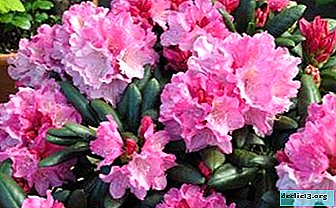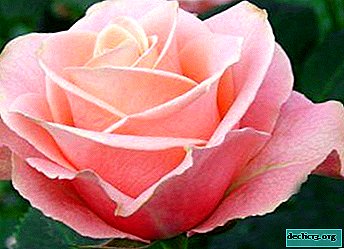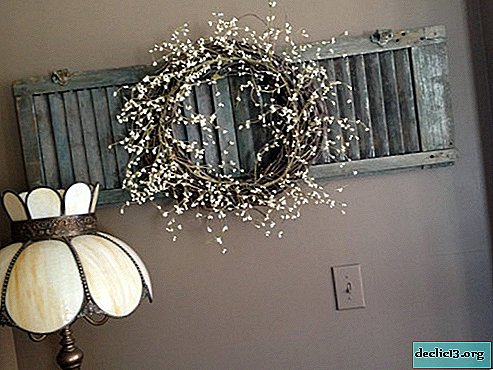Delicate roses Anna: description and photo of the variety, flowering and use in landscaping, care and other nuances
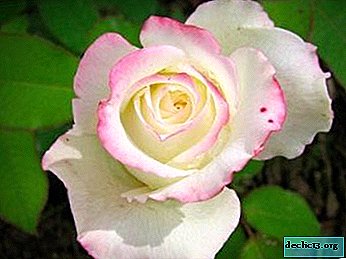
A rose is an adornment of both a bouquet of flowers and a personal plot. And today we will talk about one variety of tea-hybrid roses - Anna.
In the article you will find a description and photo of this variety, learn about the history of emergence and differences from other species, the nuances of use in landscape design, as well as understand how to achieve flowering. Get step-by-step instructions on how to care for the flower and reproduce in different ways, and also how to deal with the diseases and pests of this plant.
Grade description
The rose has a pale white color of petals, and a slight pink tint is visible on the edges from the outside. Conical buds reach a height of up to 7 cm, and when fully opened, 15 cm. The structure of the bud is densely doubled, the number of petals is about 45 pieces.
The height of the bush reaches almost 140 cm. The leaves of the bush are large and dark green in color. A variety of roses - hybrid tea.
The advantages of this variety are excellent disease resistance, high frost resistance and a small number of thorns. The rose is not afraid of rain, high humidity and tolerates hot summers, but with a strong increase in temperature, flowering of the bush may decrease.Photo
Further on the photo you can see how the rose Anna looks.



History of occurrence
This rose variety was obtained in 1990 in France by originator Paul Pecmes in a company that is a world leader in research, selection and marketing in the field of new rose varieties.
What is the difference from other species?
Rose is viable and tolerates cutting. After the flower is cut, it can stand in water for up to 14 days. In its stability and beauty, this variety is superior to all others. The variety is used for growing, both in open ground and in greenhouse conditions.
When and how does it bloom?
The flowering period of the rose is constant, it lasts from mid-June to the end of autumn. Care before and after and flowering. The development and flowering of the bush depends on how you will properly care for the rose in the first year of planting. Rose needs careful watering, quality pruning and top dressing with various fertilizers. It is important to monitor the condition of the bush so that pests and diseases do not worsen its condition.
What to do if it does not bloom?
If your rose does not bloom:
- A poor-quality seedling was selected for planting.
- Poorly lit place.
- Soil for landing prepared incorrectly.
- Too deep or low depth.
- Poor pruning of bushes.
- For wintering, the bush was poorly insulated.
- Incorrect watering.
- Lack or excess of fertilizers.
In order to solve the flowering problem, you need to dig a plant, transplant it correctly to another place and try to restore the plant with fertilizers.
Use in landscape design
 This variety of stunningly delicate roses is often used in the development of landscaping. This flower is very much appreciated for its high decorative qualities..
This variety of stunningly delicate roses is often used in the development of landscaping. This flower is very much appreciated for its high decorative qualities..
It looks great in large garden landscapes, but can also be used to decorate a small space.
In small gardens, you can make an excellent emphasis on the background of the meadow with other flowers, and in large it is better to plant these flowers in full groups. In flower beds, the rose is combined with various herbaceous perennials.
Step-by-step care instructions
Seat selection
The landing site should be located on the sunny side, but protected from drafts and strong winds. A good place to stay near buildings or tall bushes.
Timing
Spring is the best time for planting a rose, then it can take root, and wintering will be successful. In late autumn, the soil is fertilized with cow dung.
The soil
The ideal soil for planting is fertilized, loose and non-clay.
Landing
Seedlings
How to choose? Seedlings are best purchased in March, when choosing, pay attention to its quality. The root system should be without signs of decay and have a "healthy" look. On the bush should be developed from 3 to 4 shoots.
Before planting, seedlings are best stored in the basement, sprinkling the root system with wet sand. The best time for landing is from May to June, before the onset of heat.Before planting, the roots are soaked in water for 2 hours. For root disinfection, a weak solution of manganese is used, in which the roots are soaked for half an hour. The depth of the pit should be 50-60 cm so that the roots fit freely and do not bend. Before this, the soil is watered with 2 liters of water.
After that, half of the pit in an equal amount is filled with a mixture of earth, sand and fertilizers. Next, the seedling is planted in the prepared soil, about 2-3 cm, to the place of thickening. The soil around the plant is slightly compacted, and an embankment is created from the ground, so that during irrigation water flows to the roots.
Seeds
 Fruits harvested at the end of summer are considered better. After harvesting, the fruits are cut into two parts to extract the seeds. Seeds are washed in hydrogen peroxide for 20 minutes using a sieve. This is done to destroy various bacteria. Seeds can be planted both in the garden and at home.
Fruits harvested at the end of summer are considered better. After harvesting, the fruits are cut into two parts to extract the seeds. Seeds are washed in hydrogen peroxide for 20 minutes using a sieve. This is done to destroy various bacteria. Seeds can be planted both in the garden and at home.
- For growing a house, seeds are laid out between a substrate dipped in hydrogen peroxide.
- Further, this whole structure is covered with a film or bag and put in the refrigerator.
- For 2 months, the seeds are inspected and moistened, if necessary.
- When the seeds are ripe, they are planted in pots. The first 10 hours they will need good lighting.
- In order for the root system to develop, the first grown flowers should be cut off.
For planting seeds in the garden, seeds are grown in a similar way and after that they are planted in the ground with well-fertilized and loose soil. Seed planting time is August.
Temperature
This variety is unpretentious to climatic conditions, it is resistant to temperature extremes, and tolerates frosts well. But for the winter, the beds will still have to be covered.
Watering
Watering roses should be plentiful, but sparse, once a week is enough. Water is better to use rain or melt. When watering, it is important that the buds and leaves are not wet. After planting and during flowering, the bush can be watered up to 3 times a day. In the fall, watering should be excluded. Watering is possible only if there is no rainfall.
Top dressing
For abundant flowering, bushes are fed with mineral fertilizers, and for improving the composition of the soil organic. It is not necessary to feed in the first year, since fertilizer has already been applied during planting.
To prepare for winter, the leaves are sprayed with potassium sulfate.. The first top dressing is applied in the spring, with dry mineral fertilizers. After watering, the fertilizer scatters around the bush, then is closed up and watered again.
After a week and at the end of the season, organic fertilizer is introduced - a mullein solution. It unfolds around the bush, loosens with the ground and is watered. When the rose has an ovary of buds, it is fed with cow manure infusion. In the active period of flowering, it is not recommended to feed the bush.
Weeding
For roses to bloom actively, you need regular weeding of the bush from weeds.
Mulching
Mulching is carried out in the spring. This procedure further nourishes the root system and reduces the number of weeds. The material for the mulch can be straw, compost, humus leaf. The thickness of the mulch should be at least 5 cm.
Loosening
The soil must necessarily loosen, it is better to do it after top dressing or watering once a month. This is done in order to saturate it with oxygen. The earth must hold moisture well; this is good for the root system.
Pruning
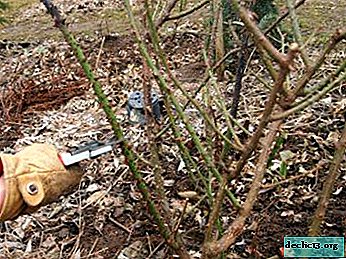 Preventative. Preventive pruning is carried out in early spring, to combat fungal infections and various diseases of the bush. The shoots of roses are cut short, leaving only a few buds. Cropped shoots burn. After pruning, the plant is sprayed with 3% solution of copper sulfate.
Preventative. Preventive pruning is carried out in early spring, to combat fungal infections and various diseases of the bush. The shoots of roses are cut short, leaving only a few buds. Cropped shoots burn. After pruning, the plant is sprayed with 3% solution of copper sulfate.- Formative. Formative pruning is carried out annually, with the advent of spring. The bushes are carefully inspected, after that the extra shoots are cut off. It is important that the pruning does not harm the flowering of the bush, and that there are no extra shoots on the rose. If pruning is not done in time, then long shoots will soon grow, which will negatively affect the development of the bush.
Transfer
Bushes are transplanted in the fall. The bush is dug up so that the root system is not affected. But even if some of the roots are damaged, the restoration will pass quickly.The bush is dug up gradually from all sides, slowly deepening into the root system. Having reached the core root, which goes deep into the ground, it is chopped off. Next, on a pre-cooked large package, a bush is laid out. The new landing pit should be larger than the previous one. Planted rose must be watered and mulched. Pruning should be postponed until spring.
Preparation for winter
In order for the bushes to winter well, they must be covered with dry leaves or branches of pine trees. Sprinkle with peat or earth on top, up to 25 cm high.
Breeding
There are two ways of propagating roses: cuttings and grafting.
Cuttings
- Shoots, the wood of which has not matured to the end, is cut and divided into cuttings, the length of which is about 6 cm. Each shoot should have at least one bud and leaves.
- The shoots are dried, and the lower section is sprinkled with a stimulant, which affects the growth of the roots.
- The plant is planted in soil saturated with fertilizers and covered with a film.
- Airing, watering and spraying is carried out regularly.
- For the winter, plants are insulated, and in the next season they are transplanted to a new place or reared.
Vaccination Method
 For vaccination, rosehip stock is used not older than 3 years. Vaccination is carried out in July or August..
For vaccination, rosehip stock is used not older than 3 years. Vaccination is carried out in July or August..
- On an annual faded shoot, blanks about 1 cm wide with two, three buds are cut.
- On the resulting scion, leaves and thorns are removed.
- In the middle of the cuttings, a kidney is cut off along with a small piece of bark.
- Near the rosehip they scatter the soil and expose the root neck - the place where the trunk goes to the root.
- A cut similar to the letter T is made on the neck to connect the stock and scion.
- The vaccination site is wrapped with a film, leaving the kidney open.
- Sprinkle the root neck so that the place of budding is hidden.
Diseases and Pests
Diseases and diseases of the rose include:
- downy mildew;
- caterpillar leafworm;
- caterpillar moth;
- green aphids.
If caterpillars of leaf moths or moths appeared on plants, then chemical preparations should be used. All damaged foliage should be cut off and burned. The main cause of powdery mildew is humidity. The leaves are first covered with mold, and then brown-red spots. To kill insects, the bush is sprayed 2 times a week with a solution of baking soda. The procedure should be carried out from spring to the end of June.
Another pest is green aphids. A soap solution with which the stem and leaves are sprayed can cope with it. A bar of soap is boiled in 10 liters of water, and then infused for 15 minutes. The procedure should be repeated after 7-10 days.
This rose variety requires appropriate care. And if you make the necessary effort, you will enjoy the flowering of these beautiful roses all season long.

 Preventative. Preventive pruning is carried out in early spring, to combat fungal infections and various diseases of the bush. The shoots of roses are cut short, leaving only a few buds. Cropped shoots burn. After pruning, the plant is sprayed with 3% solution of copper sulfate.
Preventative. Preventive pruning is carried out in early spring, to combat fungal infections and various diseases of the bush. The shoots of roses are cut short, leaving only a few buds. Cropped shoots burn. After pruning, the plant is sprayed with 3% solution of copper sulfate.

